Tea in July



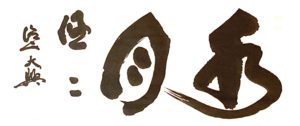

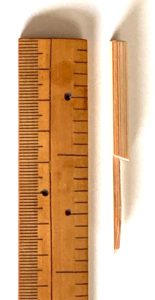
Left: Take ji-zai, 竹自在, bamboo self-exist, made of go-ma dake, 胡麻竹, foreign-flax (sesame) bamboo, for hanging a scroll or other object; L. 18 sun kane-jaku, with adjustable, screw-back, metal ori-kugi, 折釘, fold-hook. As the size of a kake-jiku, 掛軸, hang-scroll, varies greatly, it is necessary to hang the scroll so the center of the main paper is located at the exact center of the back wall of the tokonoma.
Above: Take kugi, 竹釘, bamboo nail, also called a jiku-kugi, 軸釘, scroll-nail, L. 1.8 sun kujira-jaku. It is driven into the wall to hang a scroll or other utensil, with flat side on top resembling a third quarter moon occurring on the 21 – 22 evening of the lunar month. The bamboo nail is also used in the mizu-ya, 水屋, water-room, to hang for drying, cha-sen, 茶筅, tea-whisk, hi-shaku, 柄杓, handle-ladle, and fu-kin, 布巾, fabric-cloth.
Note that the length of the take jizai is 18 sun kane-jaku, and the fushi, 節, node, is located where it divides the total length of bamboo into lengths of 8 and 10 sun kane-jaku. In addition, the length of the take kugi, bamboo nail is 1.8 sun kujira-jaku, and the length of the thick part is one sun kujira, and the slender part that would go into the wall is .8 sun kujira. It is remarkable that the long bamboo hanger jizai, is 18 sun kane-jaku, the bamboo nail kugi is 18 bu kujira-jaku. The relationship of 8 to 10 occurs an extraordinary number of times. The numbers 8 and 10 can be interpreted and written ya-ta, 八咫, eight-span (which implies ten), as with the ya-ta kagami, 八咫鏡, eight-span mirror, the sacred symbol of Amaterasu, the Shintō sun goddess.
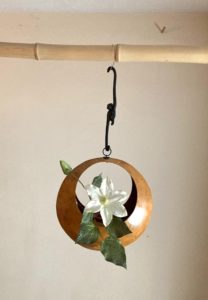
The hanger is a blackened steel hook in the form of a saru, 猿, monkey. In Japan, the monkey is thought of as rather human-like, with its many foibles. One of the great Zen images is of a monkey trying to grab the moon’s reflection on the water. Illusion compounded by illusion.
The tessen meaning refers to the exceptionally strong vine of the plant. A flower with eight petals is called a kaza-guruma, 風車, wind-wheel. The word ‘clematis’ is pronounced with an emphasis on the first syllable, while in West Palm Beach Florida, a main street is called Clematis, which is locally articulated with an emphasis on the middle syllable. The etymology of clematis is from Greek klematis, vine-break.

Bamboo plays an important role in the Buddhist world in Tana-bata, 七夕, Seven-night, and in the rites of departed spirits culminating in O-bon, お盆, Hon.-tray, beginning. Tanabata and Obon are lunar events, and will be detailed further in August Chanoyu Decoded.
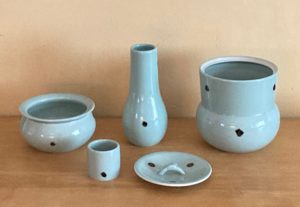
The form of the utensils is likened to the an-kō, 鮟鱇, angler-fish monkfish. The curious looking fish has a huge mouth, and is seen as quite ugly. It is prevalent in winter, so that the kaigu is deemed most appropriate in the three months of winter. The lightness of celadon can suggest coolness, and therefore is often seen in summer. The fish being a water creature provides metaphorical protection against fire.
The kaigu has its beginnings in formal settings of Tea presentations using the formal dai-su, 台子, support-of. The original kaigu was made of Kara-kane, 唐銅, Tang-copper, bronze, which was greatly influenced by the bronze utensils of the Buddhist altar. The kaigu can be used with the furo and the ro. The set of utensils is also displayed on the naga-ita, 長板, long-board. The nagaita is made in two sizes: one for use with the furo and a smaller one uses with the ro.
The five pieces of the kaigu may be identified with the Go-rin, 五輪, Five-rings, five principles of nature. The set itself is created so that each piece could fit one inside the other. The mizusashi is identified with Earth as it holds everything. The kensui is identified with Water, and would fit inside the mizusashi. The shakutate is identified with Fire (the hibashi handle fire), and fits inside the kensui. The cylindrical futaoki, also called fuki-nuki, 吹抜, wind-through, is identified with Wind, and is hypothetically slipped over the neck of the shakutate. The mizu–sashi no futa, 水指の蓋, water-indicate ’s lid, is identified with the Void, as it can change the nature of a vessel from In, 陰, open, to Yō, 陽, closed.
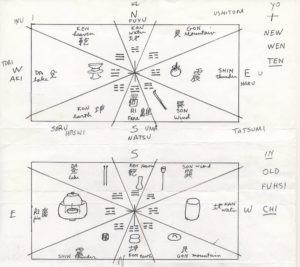
The kaigu displayed on the daisu together with the furo may be identified with the trigrams of the Eki-kyō, 易経, Change-sutra. The identification of the utensils with the trigrams of the Ekikyō with the furo, are maintained when using the ro, when the furo is removed.
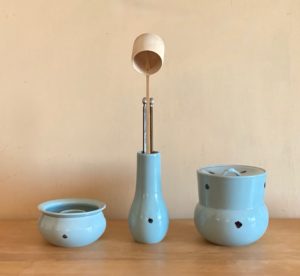
When displayed on the daisu or nagaita, the kaigu appears to be three objects. The lid is regarded as just a part of the mizusashi, and the futaoki is, correctly, hidden in the kensui; another name for the futaoki is kakure-ga, 隠家, hide-house. It is interesting to note that mizusashi is identified with Earth, the shakutate with Fire, and the kensui with Water, which are the three basic elements of form and life. The futaoki is identified with Wind, and the mizusashi lid with the Void – In and Yō.
The Go-gyō, 五行, Five-transitions, are the physical manifestations of the Gorin: Earth, Water, Fire, Metal, and Wood. Wind is identified with Metal, and the Void with Wood/life. The hidden ‘principles’ of Wind and Void are made manifest in the metal hibashi, and the bamboo/wood hishaku.
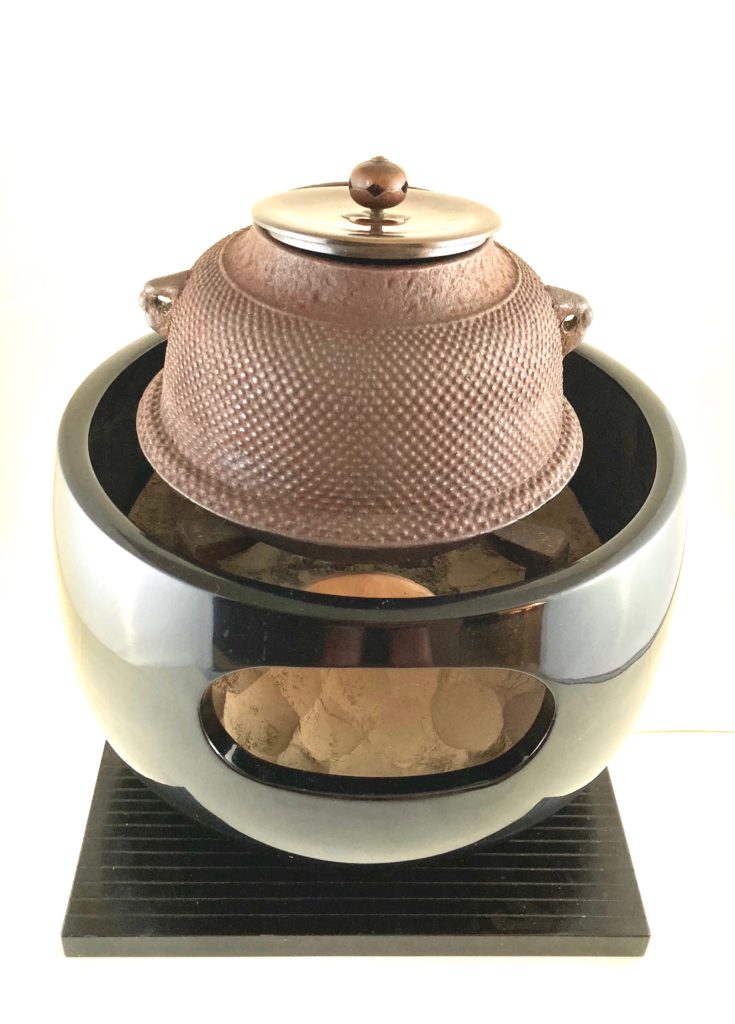

The furo and the ro with kama also manifest both the Gogyō and the Gorin. The preferred furo is ceramic, the preferred ro-dan, 炉壇, heath-foundation, is wattle and daub, Earth. Charcoal is Wood and Fire. The kama is Metal and holds Water. The kama has a lid which determines In and Yō, the Void. The word fu-ro, 風炉, wind-hearth, has Wind in the name. When the water heating in the kama reaches the proper temperature it makes a sound likened to matsu-kaze, 松風, pine-wind.
The ash bed in the hearth is called hai-toko, 灰床, ash-bed. The location of the fire on the ash bed is the hi-toko or ka-shō, 火床, fire-bed. The ashes are at times identified with Earth, particularly with using a furo that is made of metal or wood.
For further study, see also: Time for Ume: Tea in July
